Zoltán Kiss- Area Sales Manager - East Europe - Endrich GmbH.
Effective over-voltage protection solutions for the high speed I/O ports
16 MAY 2014

Summary :
Electrostatic discharge (ESD) transients are potential threats to the I/O prots of electric circuits, which challenges designers to incorporate an adequate overvoltage protection. The applied soultion however must not have any affect to the operation under normal circumstances and must not decrease the data transmission rate. The possibilities of protection with TVSD devices against ESD caused over voltage have been detailed in the previous paper, this article is more about to give an overview of the application examples, industrial standards and dedicated protective solutions for the most often used communication ports, like USB, HDMI and Ethernet.
Overvoltage protection with TVS diodes
The electronic devices coummunicate towards he otside world through communication ports, which are subject of threats of over voltage events like EDD, electrical fast transients(EST) or surges, if no adequate overvoltage protection solution is used. The protection solution must not affect the data transmission rate. Tarditional, simple protection by using a capacitor in this case will not be possible, as the capacitance of the lines should be kept low due to the high frequencies.
| DATA TRANSMISSION RATES | ||
|---|---|---|
| APPLICATION | DATA RATE Mbit/S | CAPACITANCE pF |
| RS-232 | 0.20 | < 50 |
| T1 | 1.544 | < 30 |
| E2 | 2.048 | |
| I2C | 3.4 | |
| Ethernet | 10 | |
| USB 1.1 | 12 | < 20 |
| E3 | 34.368 | |
| RS-485 | 35 | |
| T3 | 44.736 | |
| Fast Ethernet | 100 | < 5 |
| T5 | 400.352 | < 3 |
| USB 2.0 | 480 | |
| E5 | 565.148 | |
| IEEE-1394b | 786.432 | |
| GigabitE | 1000 | |
| DVI | 3960 | < 1 |
| USB 3.0 | 5000 | |
| DisplayPort | 5400 | |
| SATA 3.0 | 6000 | |
| HDMI 1.3 | 10200 | |
| HDMI 2.0 | 18000 | |
The International Electro-technical Commission (IEC) has defined a Human Body Model (HBM) ESD event to guide designers in designing adequate protections in the electrostatic applications.The IEC defined the HBM ESD discharge impulse, with four levels, in standard IEC 61000-4-2 as shown in table below.
| Level | Contact Voltage (BV) | Air Discharge Voltage (kV) | Peak Contact Current (A) | Contact Current @30ns (A) | Contact Current @60ns (A) |
|---|---|---|---|---|---|
| Level 1 | 2 | 2 | 7.5 | 4 | 2 |
| Level 2 | 4 | 4 | 15 | 8 | 4 |
| Level 3 | 6 | 8 | 22.5 | 12 | 6 |
| Level 4 | 8 | 15 | 30 | 16 | 8 |
They are up to ±8 kV contact / ±15 kV air discharges for ESD transients in systems. In some applications, a higher level is specified for enhanced contact and air discharge specifications. This is because human body models can reach n±25 kV in static-rich environments.
It has a rise time of less than 1ns and decay time of 60ns as highlighted in figure. To select appropriate overvoltage / ESD protection levels, designers must consider what external transients (ESD, EFT, surge, lightning or mis-wiring) will be applied to the equipment during installation or in operational mode. Manufacturers of Integrated Circuits (IC) with electrostatic sensitive devices design a level of protection into the IC. This is to increase resistence against overvoltage events during manufacturing process. However, added protection circuits increases costs a lot, , and to minimize such costs, IC manufacturers often design only to the level 1 standard, that protects only against 1-2 kV contact voltage. The real HBM ESD voltages can be as high as ±15 kV , which will damage the IC, therefore proper protection needs a Level 1 specification only as a secondary protection scheme. A primary protector is required against higher ±8 kV contact / ±15 kV air impulses.
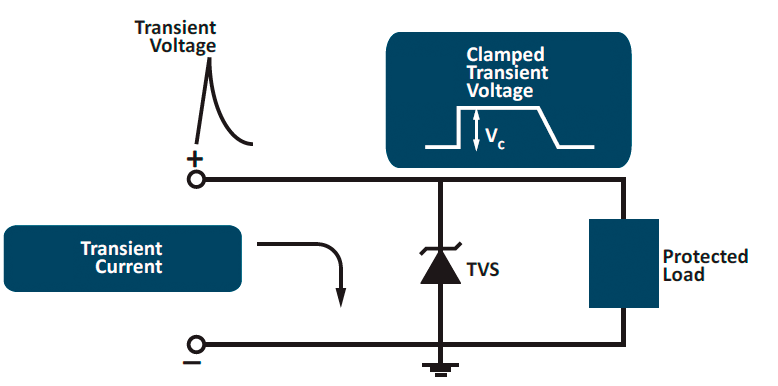
It is necessary to consider the followings, when chosing ESD protection:
- The trigger voltage before the protection device activates
- The overshoot voltage of the protection device
- The clamping voltage of the protection
Overvoltage Protection for Data Lines
Due to the passive components such as capacitors and inductors used in power supplies, ESD protection is usually solved without extra components. The capacitance of the protection device however becomes an issue for data lines, where higher baud rates are being designed. The series resistance with the load capacitance creates a first order filter, which sloves the rise and falling edge. Reducing the effective series resistance helps by setting copper dimensions. However, reducing the effective capacitance has the biggest impact on meeting expected high transmission rates.
USB port protection
Universal Serial Bus (USB) became an industry standard for computer peripherals and digital media. Today, USB ports are also used for charging and power transfer nearly as much as for data transfer. The USB specification provides a platform to allow a single USB port to drive 127 USB peripherals from a single host termination (PC). USB also allows remote powering from the host a lot of different after-market accessories like travel lights, mobile phone chargers and portable drives. USB 1.1 provides data transfer rates of up to 12 Mbps, USB 2.0 provides up to 480 Mbps and the new USB 3.0 provides up to 5 Gbps, therefore it is essential to use small capacitance TVS diodes for overvoltage protection to protect the system from faults such as hot-swapping, short circuit, ESD transients and faulty equipment.
The ProTek Devices PLR0502 single port device was designed to provide ESD protection on 5V Vbus line for USB 1.1 and 2.0. It does this with an ultra-low capacitance of 0.6 pF max per data line while having almost no leakage current. For dual USB ports designs, the PLR0504F can be considered. On higher frequency applications, even for USB 2.0 standard with its 480 Mbps, this device will have little effect on the data transfer rate.
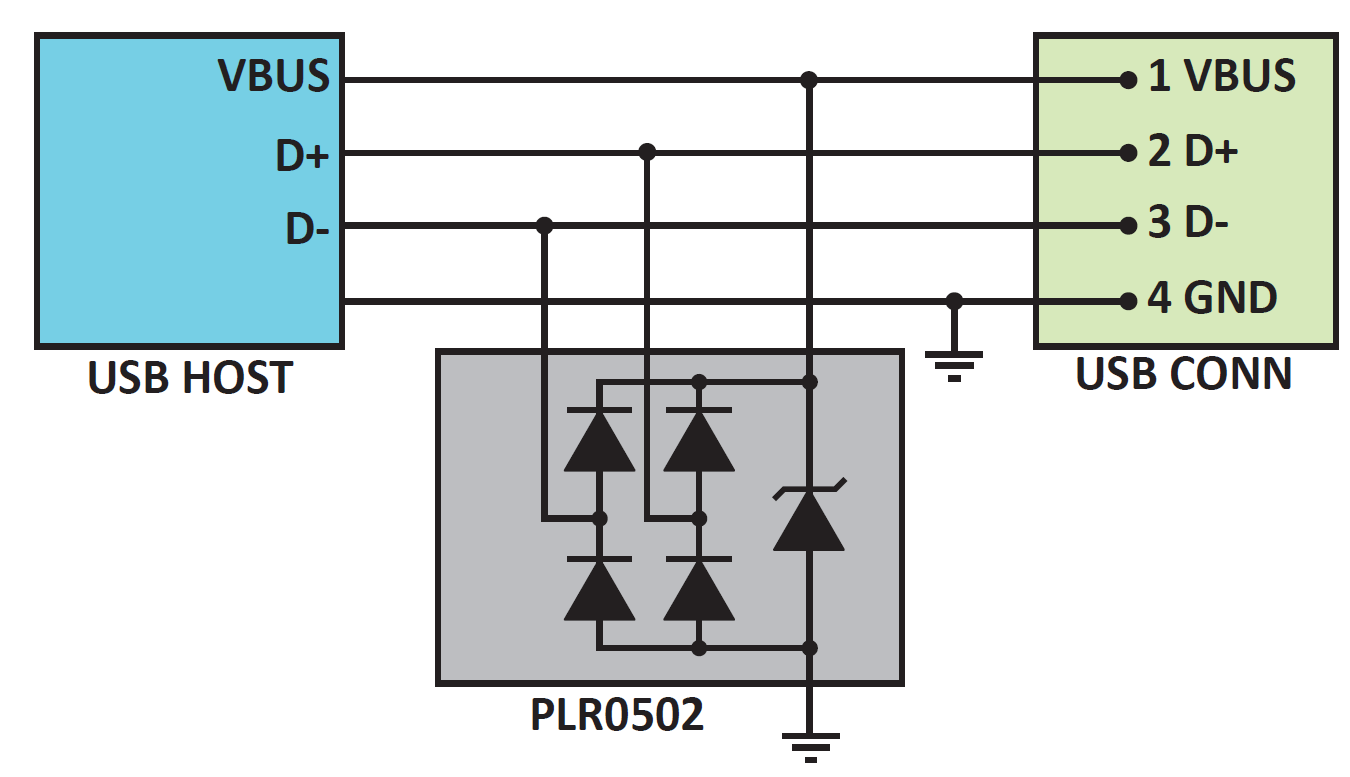
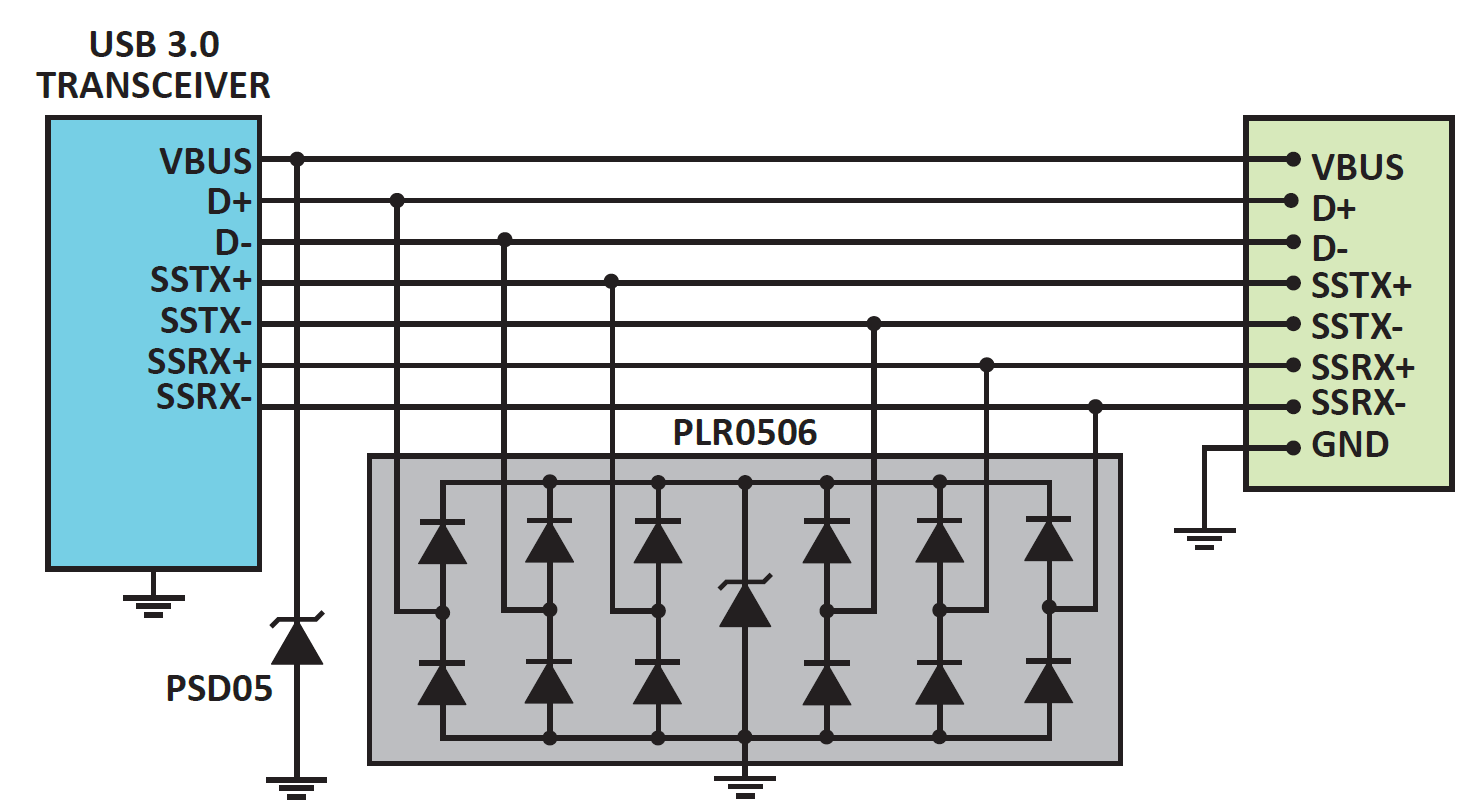
The release of the USB 3.0 standard in November 2008 offered a generational leap in performance capabilities by expanding the transmission lines to 3 differential pairs (from 1 offered by 2.0 generation). The USB 3.0 specification requires full USB 2.0 compatibility (HS, FS, LS). It also requires the new separate ultra-high speed data link, called SuperSpeed. The SuperSpeed link is working with separate differential data lines for download (Host => Device, called TX direction) and for the upload in RX direction (Device => Host). The maximum data rate in SuperSpeed mode is 5 Gbit/sec. The combination of USB 2.0 functionality and the new SuperSpeed mode requires a new cable construction. This is to accommodate servingn three differentil coupled signal lines (TX+/Tx-, RX+/Rx and D+/D-). The VCC and the GND line complete the cable set. The PLR0506 in a DFN-8 package provides 6 lines of ESD protection with a low 0.8pF capacitance rating meeting transmission requirements. In addition, the Vbus line can be protected using the GBLC05C or PSD05C devices.
HDMI port protection
HDMI is a standard for digital connection for consumer electronics to deliver a high quality audio and video signal over a single cable. The HDMI standard requires a high speed transmission rate of 18 Gbps. Since HDMI applications are used in consumer products, only ESD protection is typically required. ProTek Devices offers two solutions for HDMI designers to provide ESD protection on the 12 data lines. Protel offeres two solutions for protecting the 12 data lines. Using two PLR0506 with 6 lines of ESD protection each or an alternative option using three of PLR0524P for 4 lines of ESD protection each. Both solutions require the PSD05HP for ESD and surge protection on the Vbus line.
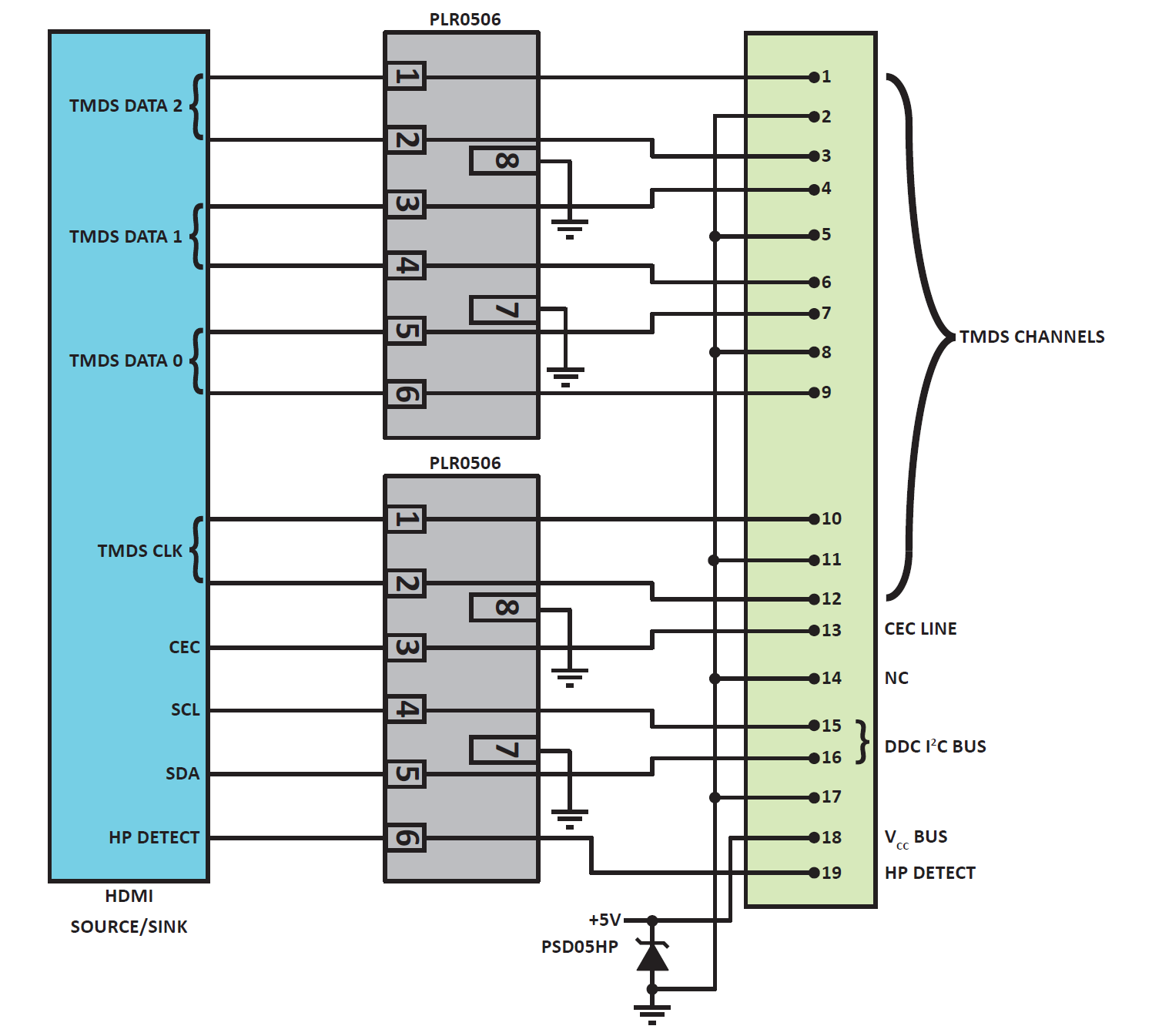
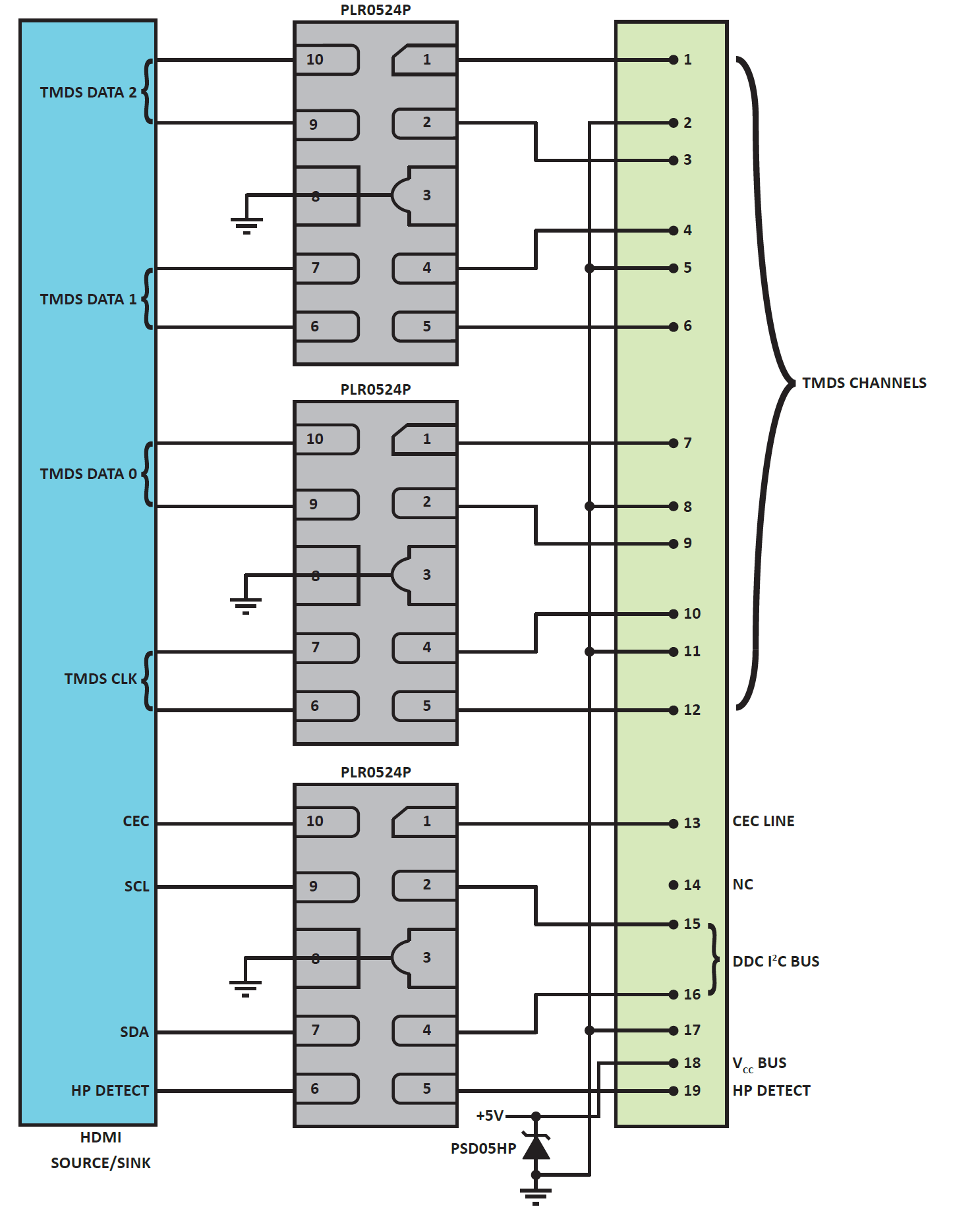
Ethernet port protection
The first element of protection to consider for Ethernet ports, is the transformer, which provides interface isolation along with the termination capacitor between the drive circuitry and communication lines. If the Ethernet transformer can support the impulse tests without failure, protection will only be needed on the secondary side of the transformer. This is to protect the Ethernet IC from the energy transfer before the transformer saturates. A typical Ethernet transformer can withstand 200-300 A 2/10μs before failure occurs. The secondary protection solution needs to ensure it can support this energy (including ESD & surge transients) without letting through too much voltage and overstressing the IC. TVS diodes are considered secondary protection. Such a device would include ProTek Devices’ PLR0504F. The goal of the primary protection is to limit the energy at the entry point to the equipment (RJ-45 socket) to ensure fewer stresses are applied to the circuit. Placing the SRV25-4 device near RJ-45 will provide up to 40A 8/20μs surge rating and ESD protection to 25kV. With its 3.5pF low capacitance rating, it can maintain high speed transmission rates. Using the SRV25-4 device will provide necessary ESD, EFT, surge protection requirements. An alternative high surge rating option is to use ProTek Devices’ PLC03-3.3 (for 3.3 V systems) or PLC03-6 (6 V for 5 V systems). These offer an integrated TVS diode and bridge diode network.
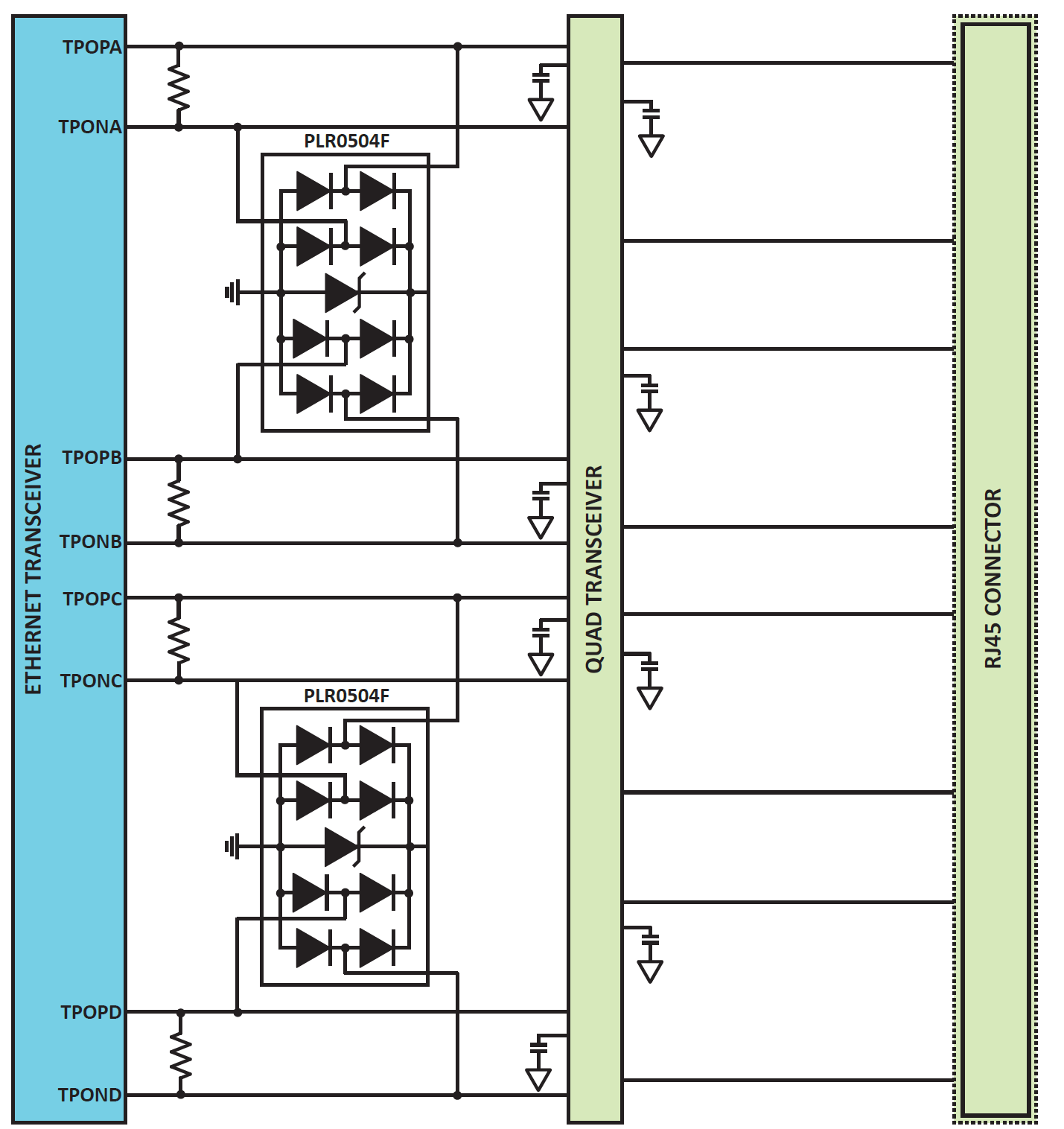
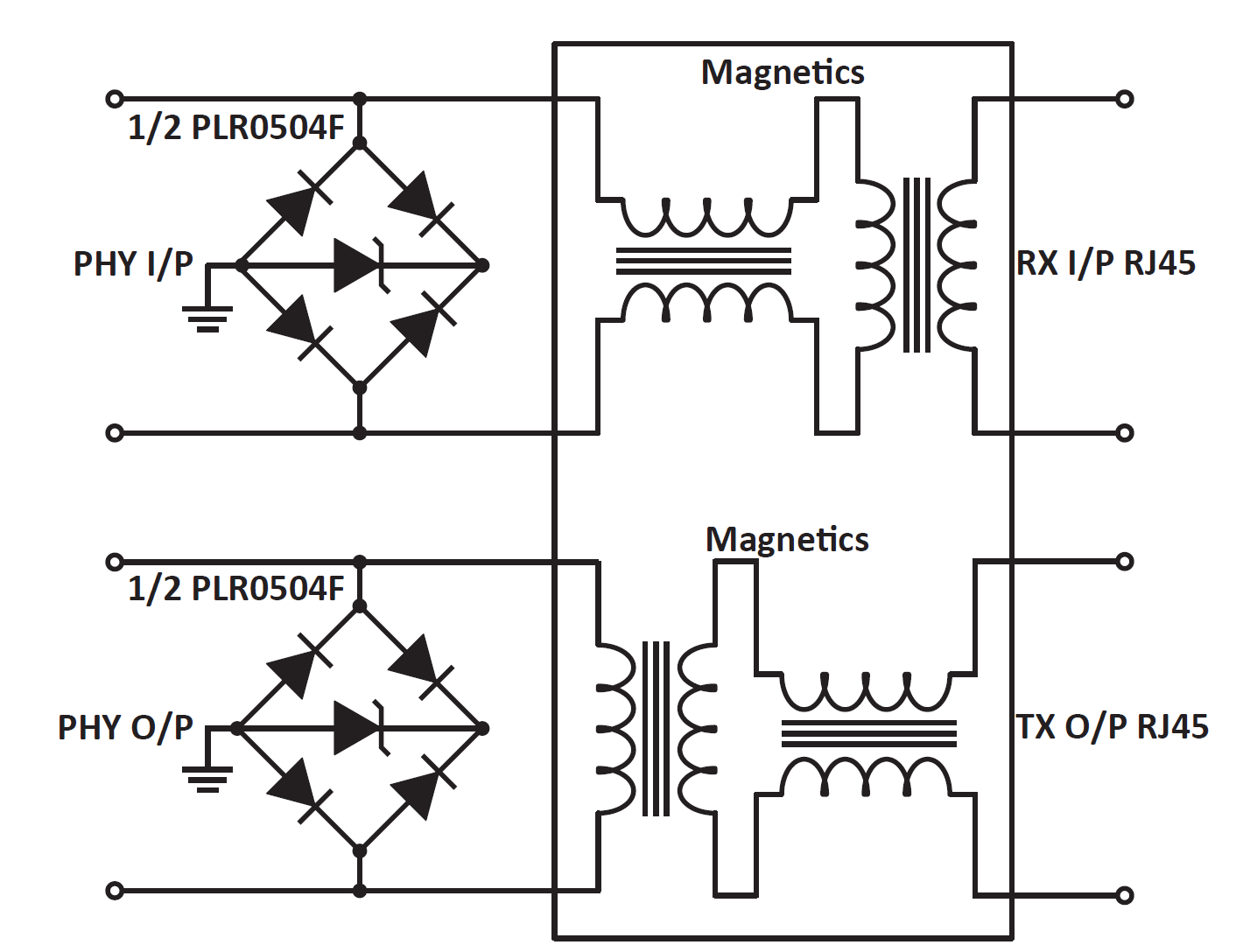
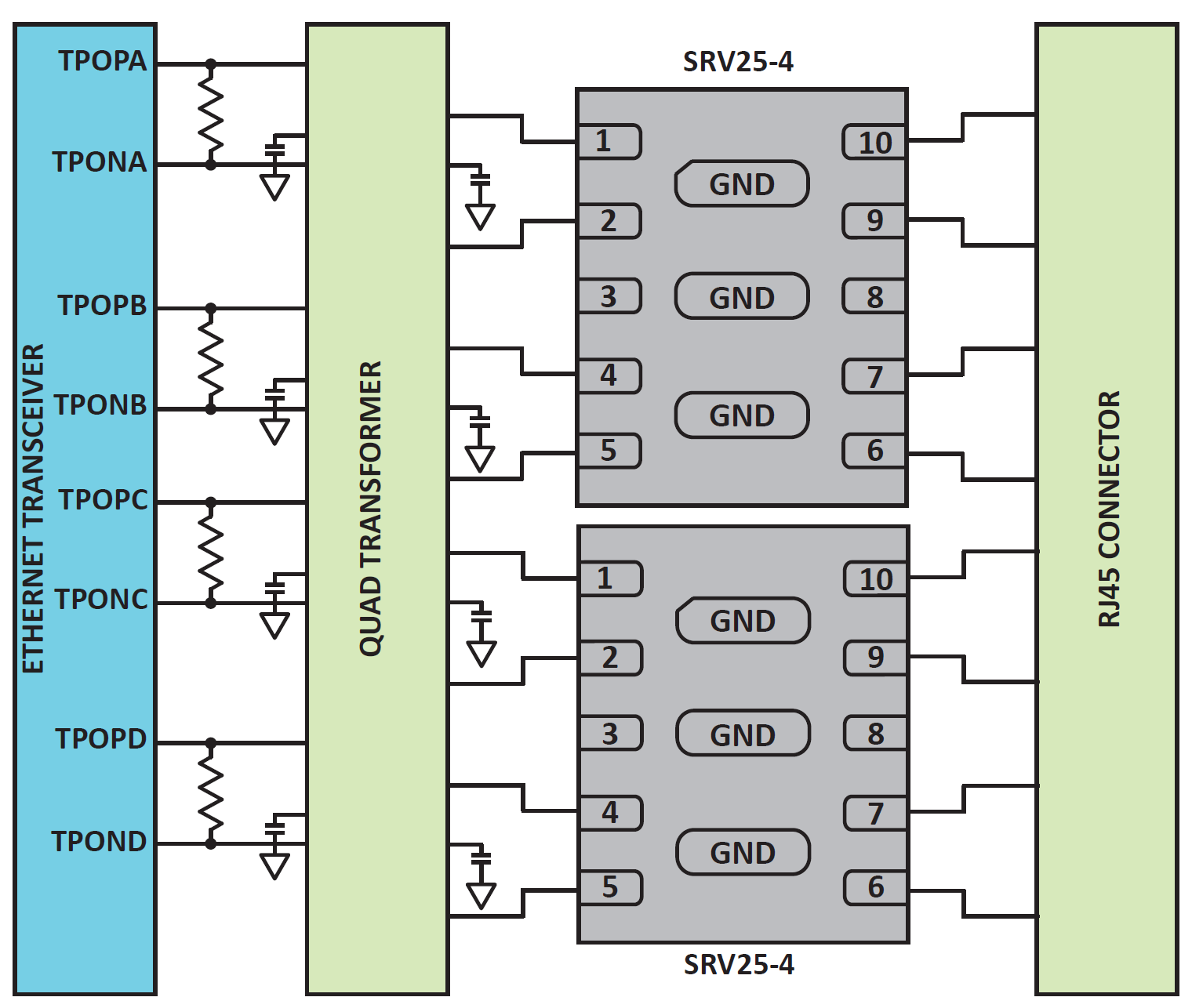
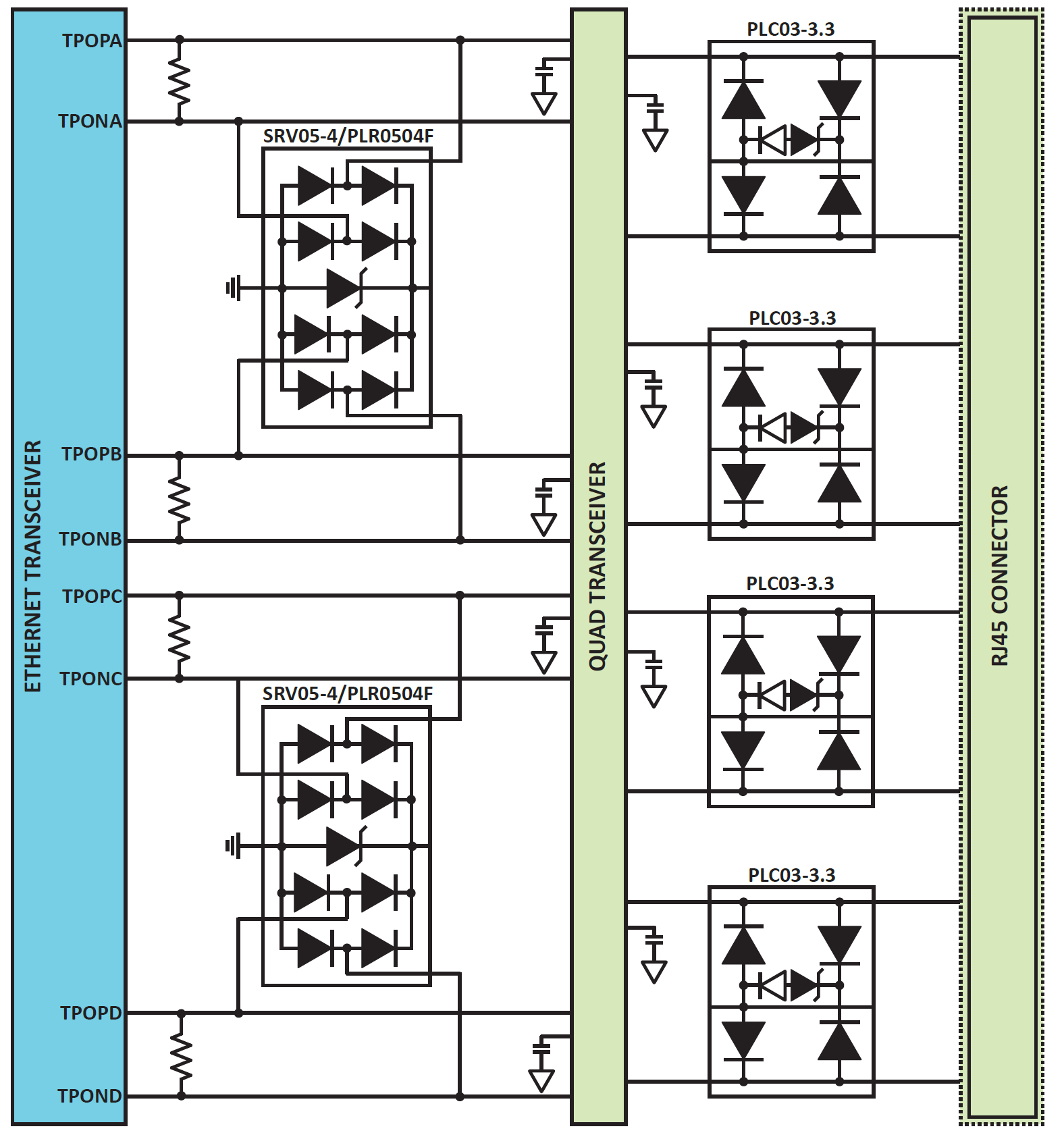
To make an overview of the different possible solutions to protect high speed data lines, the following comparison is given.
| INTERFACE/APPLICATION | MULTI-LINE TVS | SINGLE LINE TVS | ALTERNATIVE |
|---|---|---|---|
| DVI | PLR0502, PLR0508 | PLR0521, GBLC03/05CI | PLR0504F, PLR0506, PLR0524 |
| Fast Ethernet | SRV05-4, PLC03-6 | GBLC03/05C | PLR3304, SRV05-4M, SRV05-4LC |
| GigabitE | PLR0524, SRV25-4 | GBLC03CIHP, GBLC03/05CI | SLVU2.8-4, SRV05-4 |
| HDMI | PLR0506, PLR0524P | PLR0521, GBLC03/05CI | PLR0504F |
| I2C | DSOT0502 | GBLC03/05CI, PLR0521 | PSOTxx/C, GBLCxx/C |
| RS-485 | PSM712, PSLC12C | PSD12 | 485ELC |
| SATA 3.0 | PLR0524 | PLR0521, GBLC03/05CI | PLR0506 |
| Smart Battery | DSOT0502 | PSD05, P0402FC05C, PSOT05C | VSMF05LC |
| T1/E1 | PLC03-3.3, PLR3304 | GBLC03/05C | PLC03-6, SRV05-4 |
| T3/E3 | PLC03-3.3, PLR3304 | GBLC03/05C | PLC03-6, SRV05-4 |
| USB 2.0 | PLR0502, PLR0524, PLR0506 | PLR0521, GBLC03/05CI | PLR0504F |
| USB 3.0 | PLR0506, PLR0524 | PLR0521, GBLC03/05CI | PLR0502 |
| Share on Facebook | Share on LinkedIn |
References
This article has been published on the following locations:
| # | Media | Link |
|---|---|---|
| 1 | Elektronet 2014/4 | Elektronet : elektronikai informatikai szakfolyóirat, 2014. (23. évf.) 4. sz. 22-24. old. |
| 2 | Elektronet online | Nagy sebességű kommunikációs portok ESD elleni védelme Protek TVS diódával |
| 3 | Hungarian version | Nagy sebességû kommunikációs portok ESD elleni védelme |


